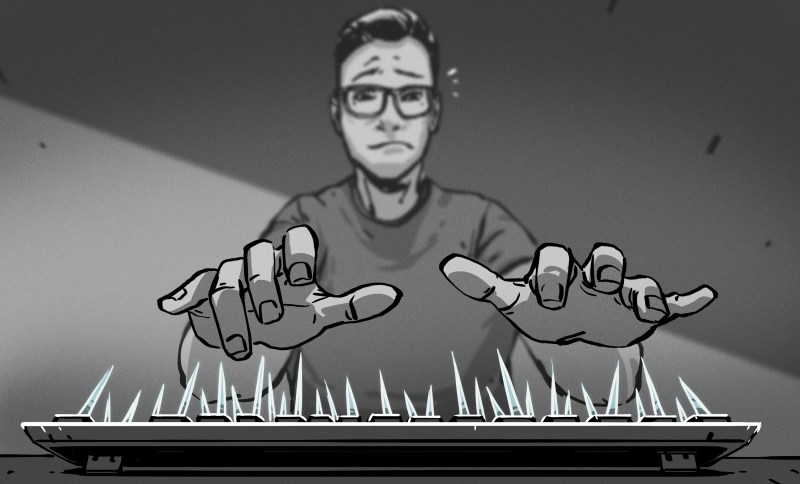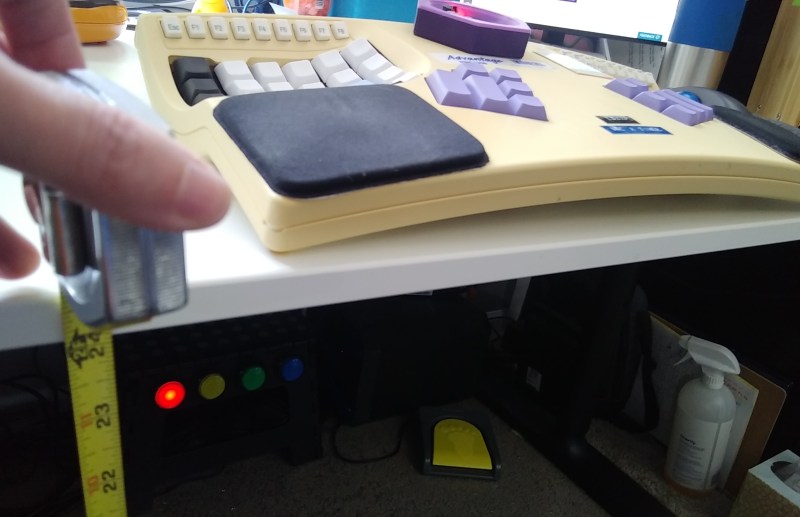
There I was, thirty years after I first sat down at an Apple IIe , and I suddenly found myself wondering if I would ever use a computer again without pain. How could I work if I couldn’t use a computer anymore? I had to seriously ask myself this question. It took a bit of a winding road to figure out what was going on and two EMGs to confirm it, but after all these years, it was clear to the medical community that I had developed a repetitive stress injury (RSI) called cubital tunnel syndrome in my left arm.

Cubital tunnel syndrome is like carpal tunnel, but in your elbow instead of your wrist. What a misnomer! Sometimes my pain went all the way from my armpit to my fingertips and made me want to gnaw my own arm off. I don’t think you can really understand neuropathy unless you’ve felt this weird, annoying type of pain firsthand. I hope you never do.
Can you stop and seriously imagine not being able to use a computer for the rest of your life? Or at least feeling that way because doing so causes incredibly annoying pain? I feel like we’re all vaguely aware of the standard list of anti-RSI precautions, but let’s review:
- maintain good posture — sit with feet flat on the floor, wrists straight, elbows at 90°
- put the screen an arm’s length away at eye level
- take frequent short breaks
Yes, those are all fine and good. But there are other things you can do to avoid computer-related RSIs, like using ergonomic inputs, and building a custom setup that fits you exactly. This isn’t a study kiosk at the university library we’re talking about — this is your battlestation! The problem is that many people are stubborn, and won’t go out of their way to do anything to proactively prevent these injuries. But you don’t have to cross a bridge when you come to it if you have a map that shows you a way around the body of water.
Don’t Be Like Me
When I started my old office job, there was a brief overview of good ergonomics. I was offered an adjustable foot stool which I took, and a keyboard tray which I didn’t and probably should have. Instead, I ground my arms into the desk for many years as I typed and used the mouse. When we moved buildings and no longer had beveled desk edges, that’s when I was really in trouble.
Don’t be happy with whatever is available. Ergonomics are for everyone at any time, so don’t wait until you need them urgently. While it’s true that companies are legally bound to provide ergonomic assessments and alternative equipment, they’re probably not going to come up to you with an IT cart full of options. You’ll have to make it known that you need it. Be proactive with ergonomics, not reactive. Someone in another department wanted a standing desk, so the office manager stayed late one night and raised a section of his desk along the cubicle wall.

Now that I work from home, I am most of the way to the perfect battlestation. I finally got an adjustable-height desk that goes low enough that I can sit at it with my feet flat on the floor and have my elbows bent at 90° angles. It’s huge and low to the ground, like a conference room table for children. But who cares what it looks like? I spend most of my waking hours at this desk. That’s 12-16 hours a day. It needs to fit me properly. Throw in the expensive miracle chair, the funny keyboard, and the trackball mouse, and I am back in business.
What’s On Your Desk?
You might be happy with what you’ve got now, but that doesn’t mean it won’t give you problems down the line. I’m not telling you to go out and buy all new equipment, but you should listen to your body. If you have leg or back pain, start with a better chair. Wrist pain? Try some ergonomic keyboards and mice.
I think you should care about your setup, and I don’t mean to take care that everything matches or has RGB. The choice of a keyboard is an important one and should not be based solely on aesthetics. You use these things how many hours a week?
I know, I know. Keeping to all these anti-RSI recommendations feels totally uncool, like riding a skateboard in public with a full set of neon protective gear on. But as long as you’re aware of the signs and keep the precautions against it in the back of your mind, you might just be alright. All it takes is one bad habit, repeated mindlessly dozens of times a day.
0 Commentaires